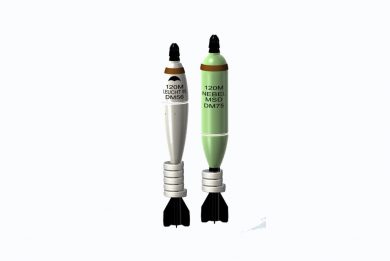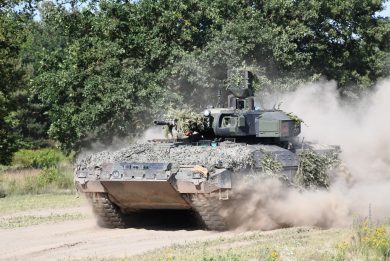
TG-MIL Protected, the RMMV militarised truck offer with armoured cabin
At the Mobility Days 2025 RMMV hosts could see for the first time a TG-MIL (Trucknology Generation – MILitarised) truck fitted with a protected cabin, a further step for allowing the use of commercial trucks derivatives in tactical situations, where performances of full military trucks are not required
During the many military asymmetric operations of the past decades, military trucks travelled mostly if not only on paved roads, therefore the high mobility performances of pure military trucks were not needed. In its portfolio RMMV has an intermediate level of trucks between the purely commercial “white fleet” and the fully military platforms, the HX trucks; known as TG-MIL, these are an evolution of the purely commercial trucks, at a level that ensures safe military use even in operations, while maintaining a high commonality with MAN commercial trucks, which allows exploiting the MAN worldwide service network. And of course, the cost per unit is much lesser than that of an HX military truck.
Even in the unprotected version TG-MIL trucks have a stronger cabin, which complies with ECE 29-3 safety requirements in terms of frontal impact, roof, and rear wall resistance. The dashboard and individual controls were modified to improve ergonomy, dashboard being NVG-compatible. Lighting is an issue in the military world, on one side when travelling in normal conditions headlights must provide good light, while remaining protected, military trucks often operating in situations where some hits might easily happen, on the other at night, when moving tactical, blackout and infrared lights are needed. The latter are located below the steel bumper, while white and daytime running lights have been repositioned. All lights can be equipped with protective grilling.

The TG-MIL family is powered by the same MAN D2676 diesel engine installed on the military HX family, also available on the white fleet TGS trucks, which provides an output up to 520 hp; it complies with Euro II, V and VIe-standards and is compatible with NATO fuel F34. One of the key issues on the TG-MIL is the adoption of the new electric electronic architecture that allows the adoption of several advanced driving assistance systems, which are becoming typical in the automotive world. Among those we can find the automatic cruise control, the emergency brake assist, the attention guard, the lane departure warning, the traction control system, and the driver’s airbag and seat-belt tensioner. Cyber becoming an issue, the Mission Mode enables the driver to deactivate all actively transmitting vehicle functionalities including advanced driving assistance systems to reduce the cyber threat.
Back to the cabin, the reinforced roof is fitted with a round hatch at the centre and has provisions for installing a swivel mount, the central seat converting to standing gunner’s platform. Additional equipment can also be installed over the roof. Modular mounts for C4I systems are available in the cabin, as well as individual weapons holders.
TG-MIL trucks can be fitted with tires up to 14.00 R20 with optional central or semi-automatic tyre inflation systems and run flat inserts, can ford up to 750 mm, and can be equipped as option with a self-recovery winch.

The last addition is the protected cabin; no details were provided on the protection level, but it is to assume that this might be one level less than the HX full-protected cabins. At the Offroad Zentrum Stotzing event, part of the RMMV Mobility Days 2025, the TG-MIL 6×6 with the protected cabin remained at the static display. When fitted with the protected cabin the truck is named TGS-MIL Protected, the cab produced by Rheinmetall being available only on 6×6 and 8×8 versions, as on the 4×4 it would leave only marginal payload. With the TGS MIL Protected RMMV is targeting those customers that need protected logistic mobility at reasonable cost, with the further advantage that those can complement the TGS-MIL unprotected fleet, considerably reducing the logistic footprint and increasing cost efficiency.
Photos courtesy RMMV and P. Valpolini



